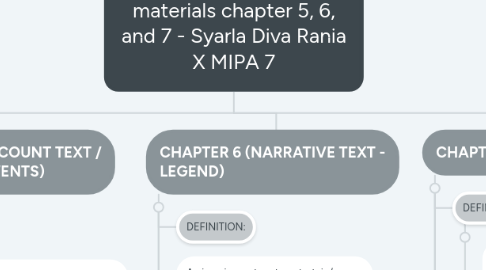
1. CHAPTER 5 (RECOUNT TEXT / HISTORICAL EVENTS)
1.1. DEFINITION:
1.1.1. Is a text that used to explain and retell factual events in the past that has historical values.
1.2. STRUCTURE:
1.2.1. 1. Orientation; consist of background information needed to understand the text (what, when, where, who)
1.2.2. 2. Events; sequence of the events in chronological order
1.2.3. 3. Re-Orientation; summarize of the events that consists of what happened in the end and a personal comments about the events from the writer
1.3. LANGUAGE FEATURES:
1.3.1. 1. Past tense action verb; what people have done. Ex: Discovered, Invented, fought
1.3.2. 2. Adjectives; objects. Ex: Hungry, sleepy, speedy
1.3.3. 3. Chronological Connection; used to connect sentences or other forms. Ex: next, after, first, then
1.4. KIND OF RECOUNT TEXT:
1.4.1. 1. Personal; tells personal experiences.
1.4.2. 2. Factual; tells about something that really happened.
1.4.3. 3. Biography; a written history of a person’s life
2. CHAPTER 6 (NARRATIVE TEXT - LEGEND)
2.1. DEFINITION:
2.2. An imaginary story to entertain/amuse the reader/listener
2.3. STRUCTURE:
2.3.1. 1. Orientation; the opening paragraph of the text which introduces who the characters are involved in the incident (who), the background time (when), and the background of the event (where)
2.3.2. 2. Complication is located after the orientation is completed. Complication consists of a paragraph explaining the beginning of the problem. The beginning of this problem also begins a series of plot (story line) which will then continue to conflict, climax, and anti-climax of the story
2.3.3. 3. In this section, there is a settlement that makes the storyline end. Every problem that arises there must be a solution, it can be closed with a happy ending or a tragic or sad ending
2.3.4. 4. Re-Orientation; is the closing sentence that tells the final condition of the character in the story or the moral message of the story
2.4. CHARACTERISTICS:
2.4.1. 1. Simple past tense; was, were, had, did, took, went, etc
2.4.2. 2. Adverbs of time; once upon a time, one day, long time ago, etc
2.4.3. 3. Direct Speech; She said, “i’ve been studying a lot.”
2.4.4. 4. Indirect Speech; she said she had been studying a lot.
3. CHAPTER 7 (SONG)
3.1. DEFINITION:
3.1.1. A composition of voice in sequence, combination and temporal relation to produce a musical composition that has unity and continuity
3.2. SOCIAL FUNCTION:
3.2.1. To express feeling and idea in an entertaining way and consist of moral values that hidden in the lyrics
3.3. GENERIC STRUCTURE:
3.3.1. 1. Intro; The introduction establishes melodic, harmonic, and/or rhythmic related to the main body of song
3.3.2. 2. Verse; the exposition, describing the scene or the person, or an emotion
3.3.3. 3. Chorus; the most repeated section, so it’s the easiest remembered. A chorus is the summary of the song’s story. All the verses have been leading up to the chorus, and is usually the part of the song people sing along with
3.3.4. 4. Bridge; is the section that gives the audience time to reflect on the story, or gives them the “climax” or conclusion of the story through verses and chorus.
3.3.5. Outro/Coda; the end of the road for the song. It can repeat the intro, chorus or a refrain as an outro, or a bridge with an instrumental solo
3.4. LANGUAGE FEATURES:
3.4.1. 1. Imaginary; describes about feeling and emotion
3.4.2. 2. Rhythm; creates mood
3.4.3. 3. Figurative Language; Consist of metaphor, simile, hyperbole, personification, and slank

